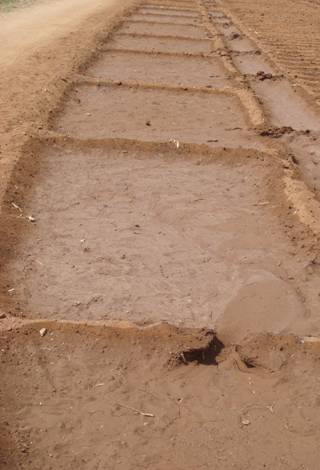CULTIVATION
Main field preparation
The soil should be very well prepared to provide an ideal seedbed. Such soil preparation also helps to control weeds, facilitates infiltration of rains and ensures that insect pupae and fungi are destroyed by exposing them to the hot sun. Adequate supply of moisture, oxygen, optimum soil temperature and freedom from mechanical impediments are the basic requirements for seed germination, seedling emergence and root growth.
Soil preparation for rain-fed groundnut depends on rainfall and soil type. For kharif groundnut, the land should be prepared thoroughly after the receipt of summer showers. This will help in sowing the crop early in the season, well before the onset of the monsoon. Ploughing should not be done when the soil is wet. Ploughing of wet soil leads to a cloddy seedbed, resulting in poor germination of seeds and a low plant population. The field should be carved into beds that will suit the border strip method of irrigation. This facilitates sowing with a seed drill and also prevents the loss of land in bunds as happens in the check basin method.
After the onset of rains, the soil is pulverized by providing two ploughings to get a good tilth. The third and final ploughing is done just before the sowing. In irrigated areas, depending upon the source of irrigation, beds of convenient size are made and sufficient ploughing is done to obtain a good tilth.
In certain areas, farmers plough their groundnut fields immediately after the monsoon crop and keep the furrows exposed till the onset of the next monsoon. They believe that the fine soil and dust deposited in the furrows by the wind during summer will benefit the groundnut that will be planted in the following season in the same furrows. |
 |
Sowing
In the case of a rain-fed crop, sowing should be undertaken immediately with the advent of the monsoon (last week of June or first week of July) and should be completed as early as possible. Delayed sowing may result in reduction in yields. In cases where irrigation facilities are available, sowing should be undertaken 10– 12 days before the onset of the monsoon with a pre-sowing watering. This helps the crop to make the best use of the monsoon showers and results in higher yields. For the rabi crop, sowing should be taken up in the months of November–December.
Method of sowing : The seeds are dibbled either manually or mechanically (using a seed drill) to a depth of 7.5–10 cm.
Spacing :
The spacing adopted differs according to the variety and from place to place.
Bunch types: 20–30 x 10–20 cm
Spreading types: 45–60 x 20 cm
In the Saurashtra region of Gujarat, farmers have the habit of planting groundnut year after year in the same furrow. They adopt a spacing of 90 cm between the rows for the spreading varieties. This traditional practice of sowing is best suited to the local ecological conditions and to available natural resources.
Interculture
Inter cultivation operations have to be started as soon as the rows of groundnut seedlings are visible, and repeated at regular intervals till 45 days after sowing or until the plants occupy a greater portion of the land. Shallow intercultivation is adequate.
Weeds
Cultural practices such as the method of sowing (broad bed/furrow system), plant density (optimum plant population of 33 plants/m2), crop varieties (spreading/semi-spreading varieties/bunch varieties), doses and methods of nutrient management and methods of irrigation, all have a pronounced effect on crop-weed interference. Weeds reduce the yield considerably. In groundnut, 20–45% yield reduction has been recorded due to weed problems.
Depending on the soil type and the extent of weed infestation, two hand hoeings and weedings should be done. The first hoeing should be done three weeks after sowing. This should be repeated in the second and third weeks thereafter before the onset of flowering. Generally, hand weeding is practised in groundnut. The first weeding is done 25 days after sowing and it is repeated once later. Weeding should not be done later than 45 days as it may interrupt peg elongation and pod formation. |

Weed free groundnut field |
Earthing up
Earthing up should be taken up simultaneously with intercultural operations (40 days). It facilitates maximum penetration of pegs and provides a larger spreading area. Apply gypsum @ 500 kg/ha during earthing up to facilitate peg penetration and to obtain good oil content.
Source : Centre for Indian Knowledge Systems, Chennai
Updated on : Dec 2014 |


